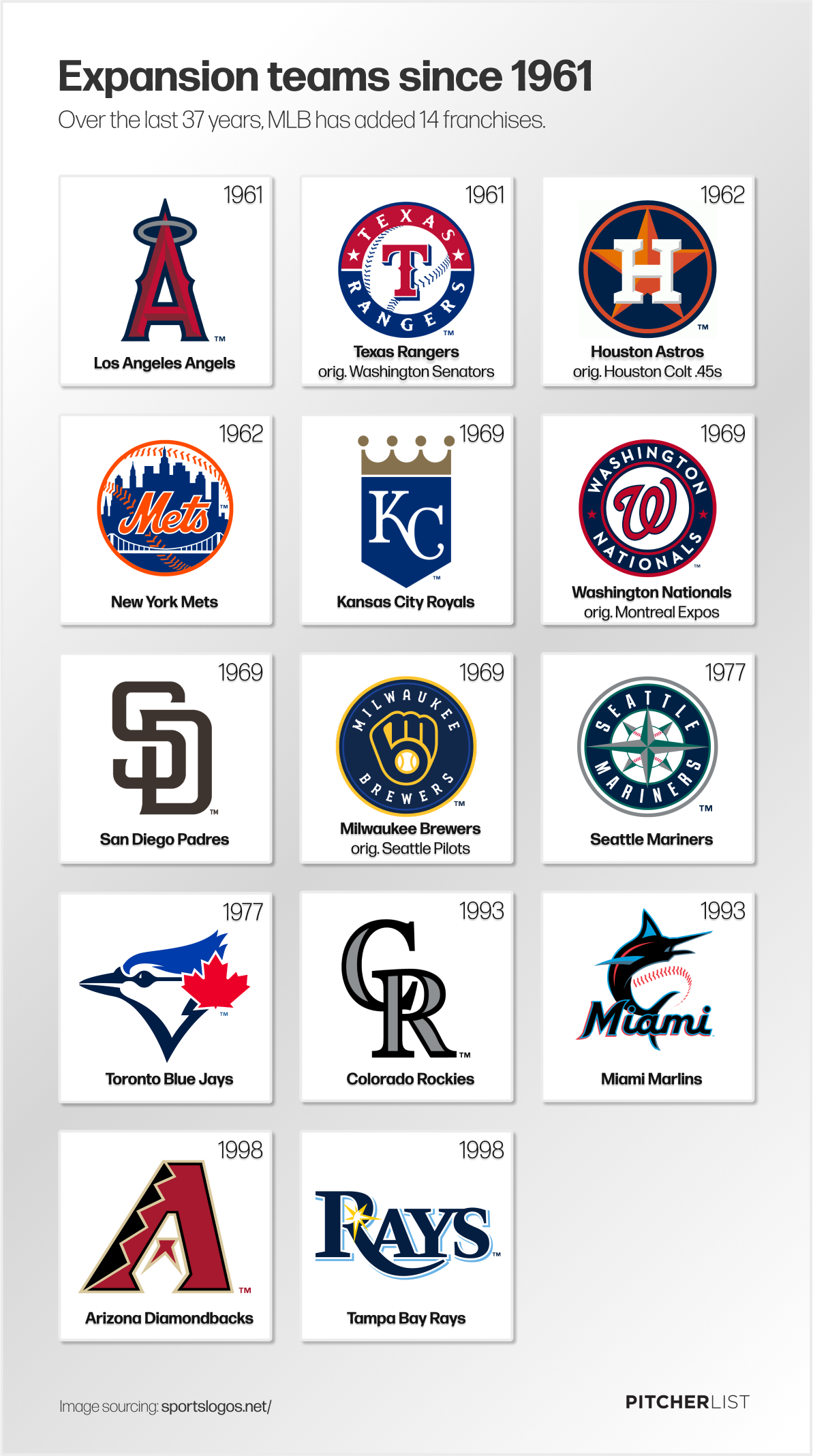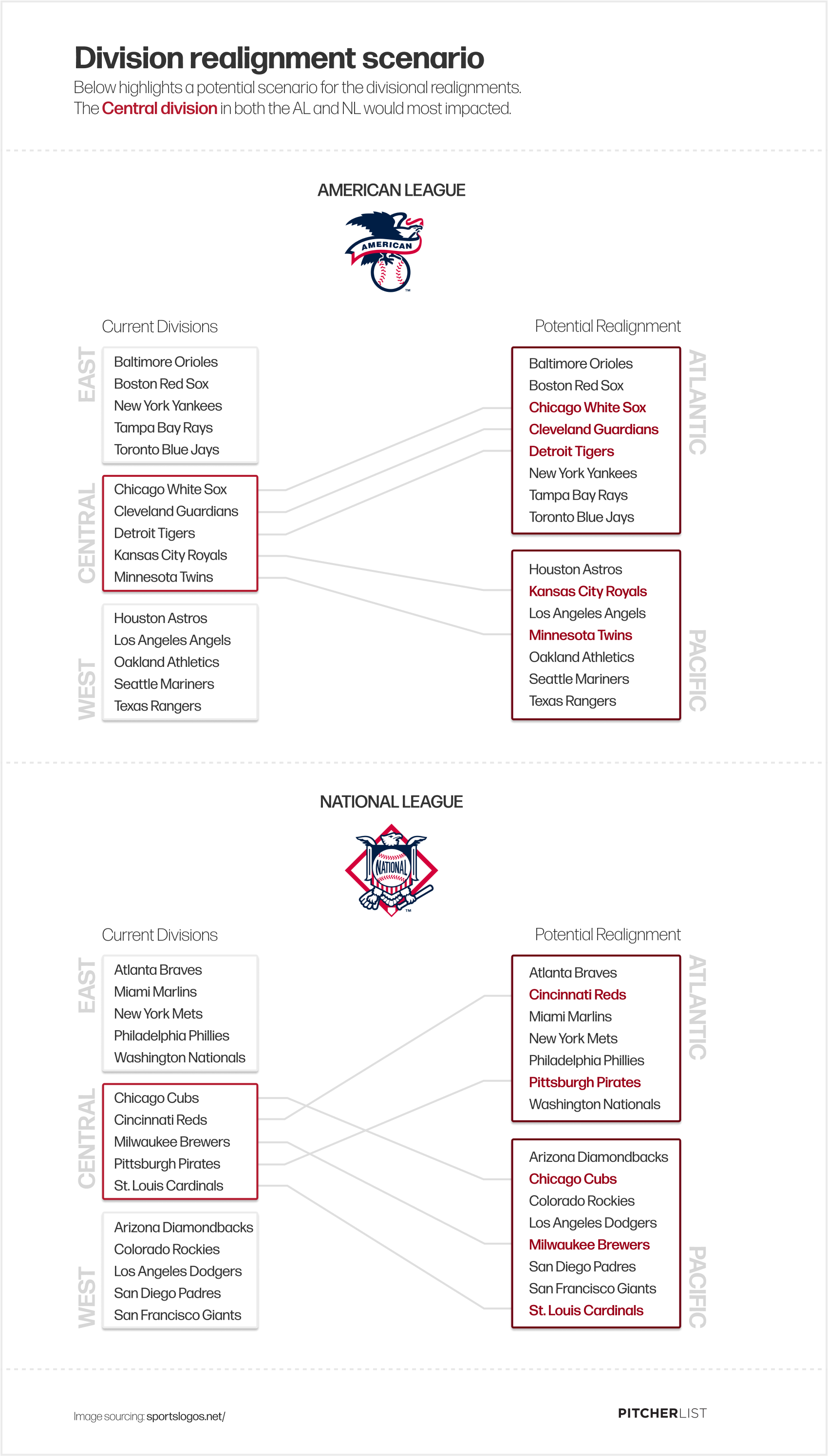Take a moment and think about the game of baseball. Not any specific teams or players, but think about the ways in which the game will change and shift over the course of the next year, the next 5 years, even the next 10 years? How will it be different? What trends will emerge? Will we see complete pitcher dominance, and if so, how long before the pitcher’s mound is moved? Could we see 500-foot blasts on a routine basis or will bunting against the shift become a go-to strategy? All these are questions you could ask about the modern game and with all those questions comes a lot of uncertainty. Pair that uncertainty with the current MLB lockout surrounding one of the most contentious CBA negotiations in recent memory and a lot of what baseball looks like over the next decade is guesswork. There are few near certainties and, like it or not, expanded playoffs are on the horizon. Take a closer look along that horizon and you’ll see, if the player’s proposal becomes reality, league expansion is a near certainty too.
MLB Expansion: A Brief History
During the 1950s, MLB saw three of its “Classic Eight” franchises move cities: the Boston Braves moved to Milwaukee, the Brooklyn Dodgers headed west to Los Angeles, and the New York Giants followed to San Francisco. As cities around the U.S. continued to grow, the number of fans also grew and the expansion opportunities were ripe. As a result, MLB added 14 franchises over the course of 37 years:

2022 marks 24 years without any expansion, making MLB the least recent of the big four North American Sports to add an expansion team. The NBA and NFL have each expanded within that timeframe and the NHL has expanded four times. MLB has been around the longest of these four, so it makes sense they saw massive expansion in a previous era. With the NHL and NFL operating with 32 teams and the NBA possibly looking to expand in the coming years, there would likely be little resistance to league expansion. A pair of MLB expansion teams would bring the total number of teams up to 32 and end the longest expansion drought since the league first expanded outward in the 1960s. With a larger league, we might see divisional realignment, a larger playoff field, or possibly both.
What Might Expanded Playoffs Look Like?
We saw a 16-team playoff format for the COVID-shortened 2020 season, but don’t expect a playoff field that large anytime soon. It worked for the irregular 60-game season, but to adopt this format would discount the 162-game regular season by allowing half the field to make the playoffs. Owners and the league office would love the extra postseason television contracts, but this format rewards mediocrity, and it is doubtful we see such a large playoff field in ’22 or beyond.
Before negotiations broke down and the owners locked the players out in hopes of forcing a resolution, MLB proposed an increase from the current 10-team playoff format to a 14-team playoff format. Under this proposal, seven teams from each league would make the playoffs (three division winners and four wilds cards), with the team with the best record receiving a bye for the Wild Card round. The remaining two division winners would have the opportunity to select their opponent, while the other two Wild Card teams would face off against each other. The Wild Card round would be a best-of-three series played at one ballpark, before advancing to the League Divisional Series. The playoffs would then follow the previous format from the LDS and beyond.
Here is where things get interesting. The MLBPA’s proposal is for a 12-team format that includes divisional realignment. Instead of an East, Central, and West division in each league, it may look a little something like this:

Very little has been reported on the Players Association’s proposal, but the only way a 12-team format works is for each outright division winner (four teams) to receive a first-round bye. The remaining eight may be made up of second- and third-place teams or they could be seeded based solely on record rather than divisional standing.
The most immediate issue with this realignment and subsequent 12-team playoff format is the uneven distribution of teams. The only way to fix that issue is to add a major league ball club to each league. How MLB looks post-expansion is an area of huge uncertainty for the game, as Rob Manfred is on record stating he hopes to see the league expand to 32 teams and four four-team divisions in each league would be the goal.
Possible Expansion Cities
Charlotte, Nashville, and Buffalo were all possible expansion sites back in the ’90s and still remain among the favorites to receive a team via expansion or relocation today. Some of the most exciting possibilities, however, come from cities that weren’t contenders back then. Considering the political support and the financial means necessary, the most likely cities for possible expansion are listed below, in no particular order:
- Las Vegas: With the city’s recent addition of the NHL’s Golden Knights, the WNBA’s Aces, and the NFL’s Raiders, as well as the NBA Summer League, Las Vegas has become one of the hottest sports destinations in the country. It remains to be seen whether the city can draw routine crowds for these events as a sizeable number of fans at these games call somewhere else home. With a 162-game MLB season, and half those games played at home, a big challenge potentially facing a Vegas franchise would be putting up attendance numbers greater than the Marlins. However, Vegas may get a team via relocation before the league expands.
- Montréal: When the Expos left town after the 2004 season, they also left nearly four million French Canadians and made Montréal the largest North American city without a baseball franchise. The Montréal Baseball Project has seen growing support in recent years and the city has most recently been discussed as a “Sister City” with Tampa. The Expos have a “magically tragic” history and the city of Montréal should be near the top of anyone’s list for future expansion sites.
- Portland, OR: Co-owned by NFL Quarterback Russell Wilson and led by a former Nike executive, the Portland Diamond Project has put together one of the most visible campaigns for MLB expansion. The main argument against a team in Portland is the proximity to the city of Seattle, but having another team in the Pacific Northwest could help to alleviate the number of miles the Mariners must travel each season. Though they may share a geographical region, the two metropolitan areas are distinct and separate enough to produce an intense rivalry from day one.
With all that in mind, how will the game of baseball look by the end of the 2020s? It doesn’t take a huge leap or stretch of the imagination to envision the possible I-5 rivalry between the Mariners and the newly formed Portland Rosebuds. How about the magic moment when the Expos 2.0 take the field in Montréal after a two-decade absence from the city? Expanded playoffs (based on the MLBPA proposal) will lead to league expansion. It’s written in between the lines, but the two are undeniably linked. It will be interesting to see how the shape this issue will take once the CBA negotiations pick back up later this winter. Until then, all we can do is daydream about this sport we all love, hoping and imagining a world with more baseball.
Featured image by Doug Carlin (@Bdougals on Twitter)
In-article graphics by Tina Covelli (@Visual_Endgame on Twitter)


Don’t forget San Jose. Sure, the Giants have the rights to that market, but I presume that the A’s just aren’t willing to meet that price. The $50M that MLB paid to the Orioles to give up the rights to Washington prior to the 2005 season equates to about $72M today.
I’m not suggestion an expansion team in SJ. I’m saying the A’s move to SJ, leaving Vegas as an expansion option.
Las Vegas has a women’s basketball team ? Wow, Vegas is really moving up in the world ! Actually who knew ? I live in Clark County Nevada and I haven’t heard of them. I hope wherever they play their fan is comfortable.
IMO A’s should move to Austin TX (Austin/San Antonio area), Rays move to Montreal, Chicago White Sox should move to Nashville. MLB expand to Vegas and Portland Go to 8-4 team divisions. MLB realign teams to expand regional play. Rays in Montreal would be in same division as Toronto, NYY and Boston. A’s in Austin same division as Texas & Houston. Portland & LV would be in same division as Seattle, LAA, Colorado would move to AL and be in same division as Austin, Texas & Houston. Orioles would move to NL and be in same division as NYM, Philly and Washington. NL Southeast – Atlanta, Miami, Pittsburg & Cincinnati. NL North Chicago Cubs, Milwaukee, Minnesota & St Louis. AL North Kansas City, Nashville, Cleveland and Detroit.
There is no way a Central-time zone team would accept being in a division with Pacific-time zone teams. Major league teams have the right to refuse being switched to another division.
I see this as only a bargaining chip for the players.
Also, I really hope they don’t expand, although they probably will. It will just create two more Cincinnati-level franchises who never sign anyone good and only contend every ten years.
Here’s how I’d do it
American League
East
New York Yankees
Boston Red Sox
Baltimore Orioles
Toronto Blue Jays
North
Minnesota Twins
Chicago White Sox
Cleveland Guardians
Detroit Tigers
South
Kansas City Royals
Colorado Rockies
Texas Rangers
Houston Astros
West
Los Angeles Angels
Las Vegas Athletics
Seattle Mariners
Portland Beavers (Expansion Team)
National League
East
New York Mets
Philadelphia Phillies
Pittsburgh Pirates
Montreal Expos (Expansion Team)
North
Milwaukee Brewers
Chicago Cubs
Cincinnati Reds
St. Louis Cardinals
South
Washington Nationals
Atlanta Braves
Tampa Bay Rays
Miami Marlins
West
Los Angeles Dodgers
San Francisco Giants
San Diego Padres
Arizona Diamondbacks
Each team plays division rivals 18 games each, non-division rivals 6 games each
Interleague format
30 interleague games, this would allow teams to play interleague rivals at home and on the road.
Let’s say the Yankees play the NL West
6 games vs. Dodgers
6 games vs. Giants
6 games vs. Padres
6 games vs. Diamondbacks
6 games vs. Mets
If they play the NL East
A whopping 12 games vs. Mets
6 games vs. Phillies
6 games vs. Pirates
6 games vs. Expos
Playoff format
7 playoff spots in each league
Wild-Card round (Best of 3)
(1) Division (bye)
(2) Division vs. (7) Wild-Card
(3) Division vs. (6) Wild-Card
(4) Division vs. (5) Wild-Card
Division Series (Best of 5, same as is)
Championship Series (Best of 7, same as is)
World Series (Best of 7, same as is)